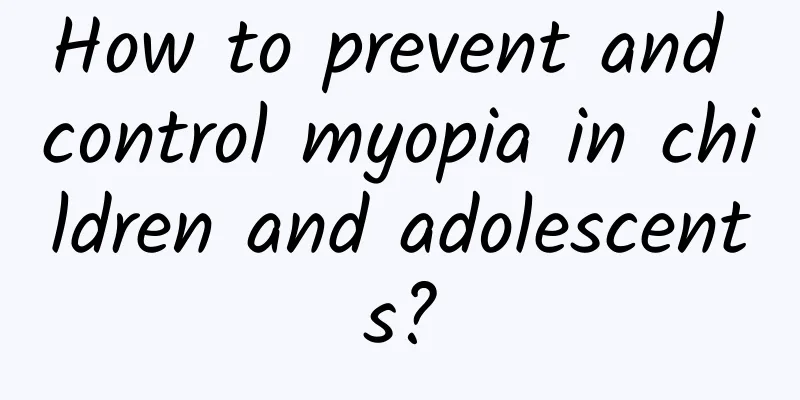How to prevent and control myopia in children and adolescents?

|
Myopia is a common refractive error among children and adolescents . In recent years, the incidence of myopia has continued to increase, and the age of onset has become younger and younger. In 2020, the overall myopia rate among children and adolescents in China was 52.7%. Therefore, prevention and control of myopia is urgent. To prevent and control myopia in children and adolescents, it is necessary to start from preschool age, pay attention to the degree of emmetropia in children, take necessary preventive measures in advance, and avoid the high incidence of myopia in children. This is of vital importance to reducing the incidence of myopia and delaying the progression of myopia during school age. Children should be screened for vision regularly. Children aged 1 to 3 should undergo refractive screening every six months to understand whether they have obvious hyperopia, myopia, astigmatism, anisometropia and other high-risk factors that cause amblyopia. Vision screening should be conducted every six months starting at the age of 4, especially before school age to understand the state of the child's hyperopia reserve and avoid the "hyperopia reserve" being consumed too early and too quickly before school age. After a child has developed myopia, it is important to control the rate of myopia development. Myopia growth is caused by the growth of the eye axis, and this development process is currently irreversible. In addition to affecting the clarity of distant objects in children and making wearing glasses inconvenient, if myopia is not controlled, as the eye axis continues to grow, myopia will continue to progress to high myopia (myopia of more than 600 degrees), especially when it is medically diagnosed as pathological high myopia, it will be accompanied by related fundus lesions, floaters, visual distortion, and even retinal detachment, macular holes, macular hemorrhage, glaucoma, cataracts and other serious complications, some of which will cause irreversible visual damage and seriously affect children's eye health. Therefore, it is important to prevent the degree of myopia from increasing too quickly and to control the degree of myopia at a relatively low level. To prevent and control myopia in children and adolescents, we should pay attention to the following points: (1) Correctly understand the importance of daytime outdoor activities and increase the time spent outdoors. Outdoor activities and exposure to sunlight can promote the release of dopamine in the eye, thereby inhibiting the elongation of the eye axis and preventing and controlling the premature onset of myopia. Therefore, children should spend at least 2 hours of daytime outdoor activities every day and bathe in the sun as much as possible. Especially for children who already have myopia, it is recommended that they spend more time outdoors during the day to control the progression of myopia. It is recommended to spend at least 2 hours of outdoor activities every day. (2) Reduce the time spent using your eyes at close range: Keep in mind the 20-20-20 principle, which means that after using your eyes at close range for 20 minutes, you should look up and gaze at a distance of 20 feet (about 6 meters) for at least 20 seconds. You should also reduce the time spent using your eyes at close range, such as reading, drawing, and writing. (3) Pay attention to the correct reading and writing posture, and keep the distance between one fist and one foot. Avoid bad reading and writing habits. Do not read or write while walking, eating, lying in bed, in a shaking car, in dim light or under direct sunlight. Pay attention to the appropriate lighting when reading and writing. Choose a desk lamp that does not flicker, has sufficient brightness, and has a wide spectrum. When using it, turn on other lights in the room to ensure sufficient brightness. (4) Limit the use of electronic video products: It is recommended that infants and young children are prohibited from using mobile phones, computers and other video electronic products. Children aged 3-6 should avoid contact with and use of mobile phones, computers and other video electronic products. Even older children should pay attention to strictly controlling their use time. (5) Ensure adequate sleep, eat a balanced diet, do not be picky about food, do not eat biased food, do not overeat, eat less sugar, and eat more fish, vegetables, fruits and other visual foods that are beneficial to vision health. (6) Children and adolescents should undergo routine vision examinations every six months. Children who already have myopia can have their eye axis checked every three months to understand the rate of myopia progression. They should also pay attention to correcting changes in vision every six months and undergo standardized mydriasis refraction to understand changes in refractive power. If necessary, glasses should be replaced in a timely manner. (7) Currently, the more effective treatments for controlling myopia include orthokeratology lenses, multifocal contact lenses, myopia defocus glasses, low-concentration atropine, etc. Appropriate control measures should be selected for children under the guidance of a doctor. In short, paying attention to healthy and scientific use of eyes is a very important factor in reducing the occurrence of myopia in children and adolescents and delaying the progression of myopia. |
Recommend
What is the best way to treat condyloma acuminatum?
We need to pay attention to the treatment of cond...
Beauty and skin care tips, Chinese medicine whitening and freckle removal tips
Female friends all hope to have fair and moist sk...
What to do if the vagina bleeds
Vaginal bleeding is a relatively serious disease ...
Can sauerkraut water be used to water flowers? What are the uses of sauerkraut water?
We all know that many people pickle sauerkraut at...
What foods can help you enlarge your breasts?
In the past, there was a saying that big breasts ...
Pregnant woman suffers from severe insomnia and does not sleep all night
As a special group of expectant mothers, they wil...
What happens if the ovulation test does not show a strong positive result? The reasons are very complicated!
Under normal circumstances, women can use ovulati...
How to turn dark nipples pink
As a woman's private part and charm, female f...
What does HPV mean in women?
Generally, when women go to the hospital for a gy...
There are four benefits for women to touch their breasts frequently
1. Early detection of lumps and lesions Many wome...
CMR: India's high-end smartphone shipments grew 18% year-on-year in the first half of 2020
Premium smartphone shipments in India grew 18% ye...
How to eliminate acne caused by endocrine disorders in women
Appearance is something that many beauty-loving f...
How to determine ovulation
The arrival of a girl's ovulation period is a...
Top five beef diet recipes, learn them quickly if you want to lose weight!
Maybe everyone has the impression that meat produ...
How long can a grass carp live in a basin? How to cut a grass carp
Fish is a food that every household eats frequent...









